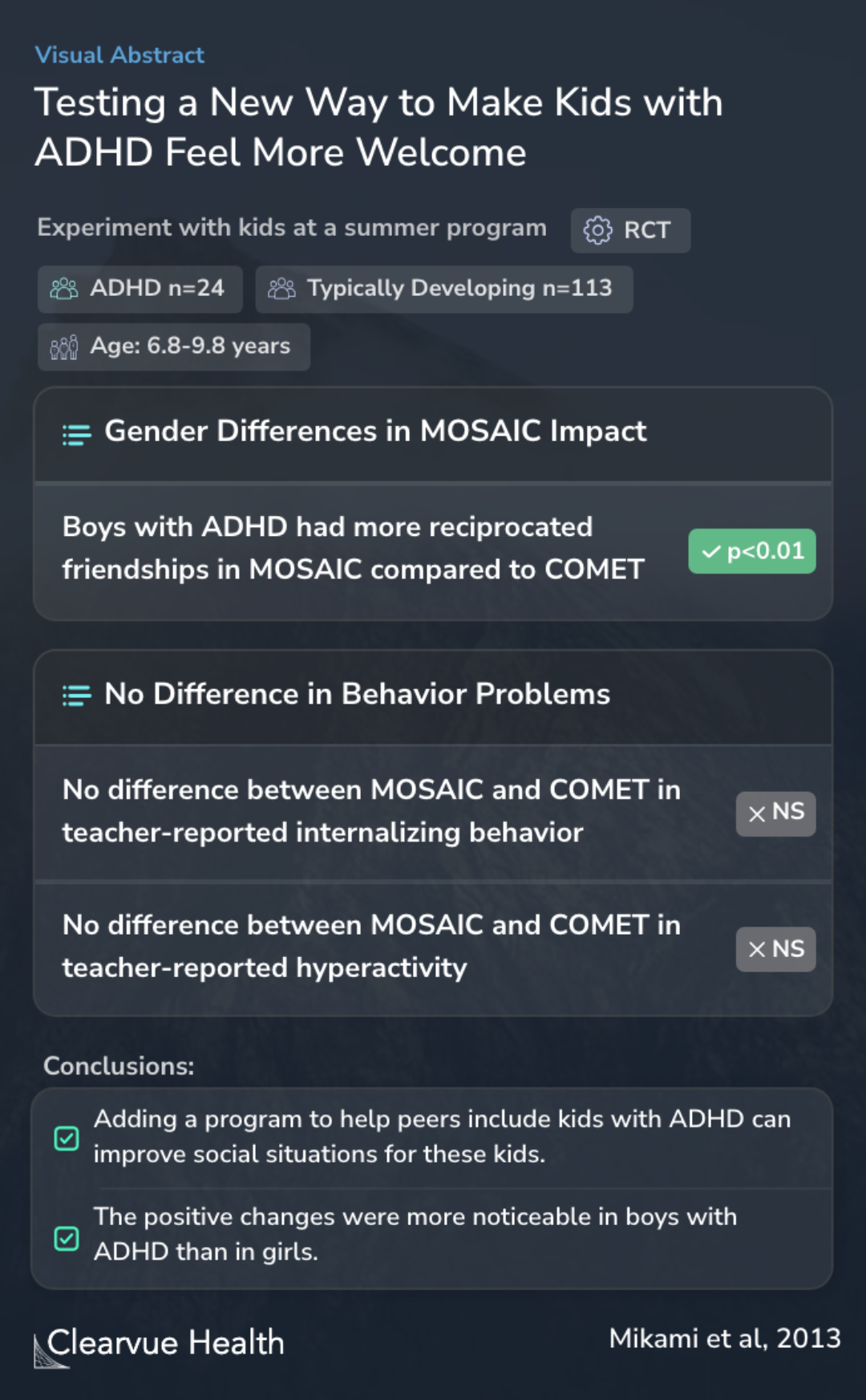A randomized trial of a classroom intervention to increase peers' social inclusion of children with attention-deficit/hyperactivity disorder
Testing a New Way to Make Kids with ADHD Feel More Welcome
Mikami AY, Griggs MS, Lerner MD, Emeh CC, Reuland MM, Jack A, Anthony MR

Objectives
The study set out to see if helping kids with ADHD get along better with others could be improved not just by helping these kids behave better, but also by teaching their classmates to be more welcoming and kind to them.
Interventions for peer problems among children with attention-deficit/hyperactivity disorder (ADHD) typically focus on improving these children's behaviors. This study tested the proposition that an adjunctive component encouraging the peer group to be socially inclusive of children with...
Methods
In an attempt to explore this, the researchers set up an experiment where they looked at two different ways to help kids with ADHD. The first way, called COMET, was about teaching these kids how to act in ways that are more likely to make others want to be friends with them, using a system where they could earn points for good behavior. The second way, MOSAIC, was a bit different. It also used the point system, but it added a special part where the teachers would talk to all the kids to make sure they understood why it's good to include everyone, even if someone might act out sometimes. They wanted to see if this extra step made a big difference.
This test was done with kids aged between 6.8 and 9.8 years during a summer program. There were 24 kids with ADHD and 113 kids who were developing typically. They were put into classes with kids they didn't know yet, which made it a good test to see if these programs could help them make new friends.
Two interventions were compared: contingency management training (COMET), a traditional behavioral management treatment to improve socially competent behavior in children with ADHD, and Making Socially Accepting Inclusive Classrooms (MOSAIC), a novel treatment that supplemented behaviora...
Results
After trying out both COMET and MOSAIC, the researchers found that both ways didn't make much of a difference in how much the kids with ADHD acted out or had trouble with feelings. But, there was a big change when it came to making friends. When the kids were in MOSAIC, they were liked more by the other kids and made more friends who liked them back. This was especially true for the boys with ADHD; they ended up with more friends in MOSAIC than in COMET. For the girls with ADHD, there wasn't a clear difference between the two ways in terms of making friends.
Whereas the level of behavior problems displayed by children with ADHD did not differ across treatment conditions, children with ADHD displayed improved sociometric preference and more reciprocated friendships, and received more positive messages from peers, when they were in MOSAIC rela...
Evidence Comparison
In light of the study's findings, the approach of combining traditional behavioral management with peer inclusion strategies, as seen in the Making Socially Accepting Inclusive Classrooms (MOSAIC) treatment, mirrors well-established practices in ADHD management. Traditionally, ADHD interventions have hinged on behavior therapy and medication, focusing largely on the individual. The current evidence underscores the importance of such interventions, highlighting behavioral therapy as a cornerstone in managing ADHD symptoms, particularly in reducing disruptive behaviors through training for parents and educators.
The paper introduces an innovative layer to this framework by integrating social inclusion tactics within the classroom setting aimed at enhancing peer acceptance and friendships among children with ADHD. This aligns with the broader understanding that ADHD management benefits from a holistic approach, addressing not just the symptoms but also the social challenges that accompany the condition. While the traditional focus has been predominantly on rectifying the disruptive behaviors and attentional deficits inherent to ADHD through direct interventions like Parent Training in Behavior Management (PTBM) and medication, the study's outcomes suggest that augmenting these with strategies that foster a more inclusive social environment can further enhance the social well-being of children with ADHD.
Conclusions
The study's conclusions offer insight into the potential of modifying traditional ADHD interventions to include components that promote peer inclusiveness, particularly in classroom settings. The findings suggest that such adjunctive procedures could play a significant role in mitigating peer-related challenges faced by children with ADHD. This underscores the value of considering broader social dynamics in the treatment of ADHD, highlighting the potential for more nuanced and inclusive approaches to enhance the effectiveness of existing interventions.
Data support the concept that adjunctive procedures to increase the inclusiveness of the peer group may ameliorate peer problems among children with ADHD, and suggest the potential utility of modifying MOSAIC to be delivered in regular classroom settings.
Key Takeaways
Context
The study under discussion sheds light on an innovative approach to ADHD management, highlighting the benefits of combining traditional behavioral interventions with strategies aimed at improving peer inclusiveness. This aligns with previous research, such as the meta-analysis by Bikic et al. in 2017, which demonstrated the effectiveness of Organizational Skills Training (OST) in improving attention, organizational skills, and academic performance among children with ADHD. The current study extends this by exploring the social dimension of ADHD management, suggesting that interventions targeting social inclusivity could further enhance the well-being and academic success of children with ADHD.
Similarly, the research by Marshall et al. in 2014, which delved into the challenges faced by children with ADHD of the inattentive type and sluggish cognitive tempo, resonates with the current study's findings. Marshall et al. highlighted the social and academic impairments in this subgroup, emphasizing the need for tailored interventions. The current study's focus on peer inclusiveness as an adjunctive treatment strategy provides a valuable perspective on addressing the unique social challenges encountered by children with ADHD, suggesting a comprehensive approach that encompasses both academic and social domains.